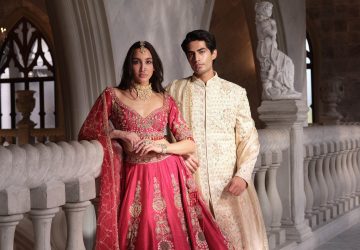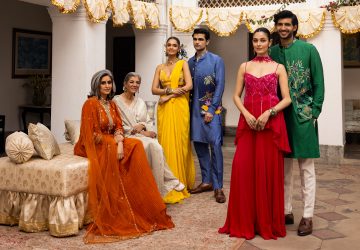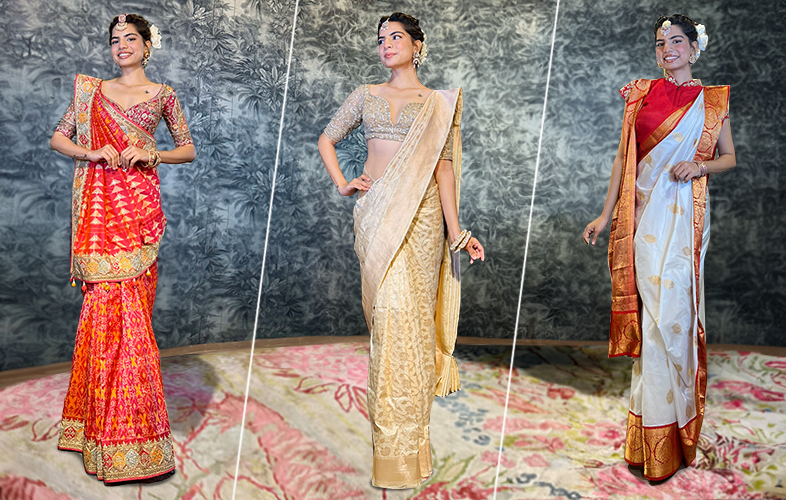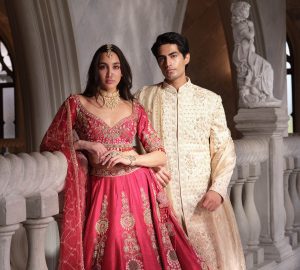Sarees hold a special place in the heart of every Indian woman, and the diversity of India’s culture is beautifully reflected in the various regional styles of sarees and drapes. From the intricate weaves of Banarasi sarees to the vibrant hues of Gujarati sarees, the artistic patterns of Bengali sarees, and the unique draping styles like Nivi, Coorgi, and Kunbi, each style tells a unique story. This Independence Day, #KALKIDrapesOfDiversity invites us to delve into the lesser-known corners of India, where untold stories reside. In this article, we’ll guide you through selecting the perfect saree and drape by considering the fabric, colors, and designs that are emblematic of these various Indian styles.
Fashion fads come and go, but the saree is timeless. The six yards of elegance depict India’s cultural richness, with each state representing a different saree draping method. The saree is the most excellent vehicle for conveying a woman’s beauty and grace, and its types and draping methods have even influenced the Western fashion world.
The Allure of Different Saree Styles: A Regional Journey with KALKI
Although most women would opt to wear a certain type of drape in their daily lives, it is worth noting that these drapes may allow for unfettered mobility and are as simple to put on as a dress. Women (although in small groups) from various parts of India have been doing it successfully for many years. Here are a handful of the more region-specific saree draping styles that are as diverse as they are gorgeous.
Misti Malla Bengali Drape (West Bengal)
The ever-popular drape, also called the Atpoure looks resplendent in a Gorod, white body, red border saree. It is draped without pleats, and the pallu is brought from the back to the front over the left shoulder. The pallu is then pinned in place. The saree style is versatile enough to be tried on different sarees, including Banarasi, Baluchari, and Jamdani. However, Bengalis flaunt this type of draping style during the Durga Puja festival in a Gorod saree, and is a sight to behold.
Gujju Pallu Saree Drape
The popular style from the state of Gujarat, the pallu is draped in the front from the right shoulder and wrapped around the body. Also called the Gujarati style, women try this style in Bandhej cotton and silk sarees, Patola sarees, and more. This type of pallu not only helps to showcase the beauty of the saree but also allows easy movements.
Shahinshahi Banarasi Drape
Banarasi sarees, a treasure trove of artistry, are known for their opulence and luxurious appeal. Crafted from fine silk and featuring intricate brocade work, these sarees exude grandeur. The color palette is rich and regal, with deep maroons, golds, and royal blues being popular choices. Banarasi sarees are renowned for their intricate and elaborate designs, often depicting floral motifs, intertwining vines, and intricate craftsmanship that showcases the weaver’s skill and dedication.
Kunbi Kala Saree Drape
The Kunbi drape hails from Maharashtra and is characterized by its unique draping style. The saree is usually worn with the shorter end tucked at the back and the longer end draped across the front, creating an asymmetrical and visually appealing silhouette. This drape highlights the saree’s designs and colors while offering a comfortable and free-spirited feel.
Classic Nivi Drape
The Nivi drape hails from Andhra Pradesh and is one of the most common and elegant ways to drape a saree. It involves neatly pleating the saree and allowing it to fall gracefully over the shoulder. The Nivi drape complements a wide range of sarees and body types, making it a versatile choice.
Coorgi Charm Drape
The Coorgi drape, native to Karnataka’s Coorg region, is known for its distinctive pleating at the back, creating a rich and layered look. It’s often accompanied by a beautifully embroidered blouse and traditional jewelry, showcasing the regal heritage of the Coorgi community.
In the world of Indian sarees and drapes, the choices are as diverse as the cultures they represent. Whether you’re drawn to the delicate artistry of Bengali sarees, the vibrant playfulness of Gujarati sarees, the opulence of Banarasi sarees, the elegance of the Nivi drape, the regal allure of the Coorgi drape, or the unique charm of the Kunbi drape, each style has its own story to tell. When choosing the perfect saree and drape, consider the fabric that suits your comfort, the colors that resonate with your personality, and the designs that speak to your aesthetic preferences. Whatever your choice, remember that each saree and drape is a celebration of the rich tapestry of India’s heritage and an embodiment of its artistic legacy.
![]()








